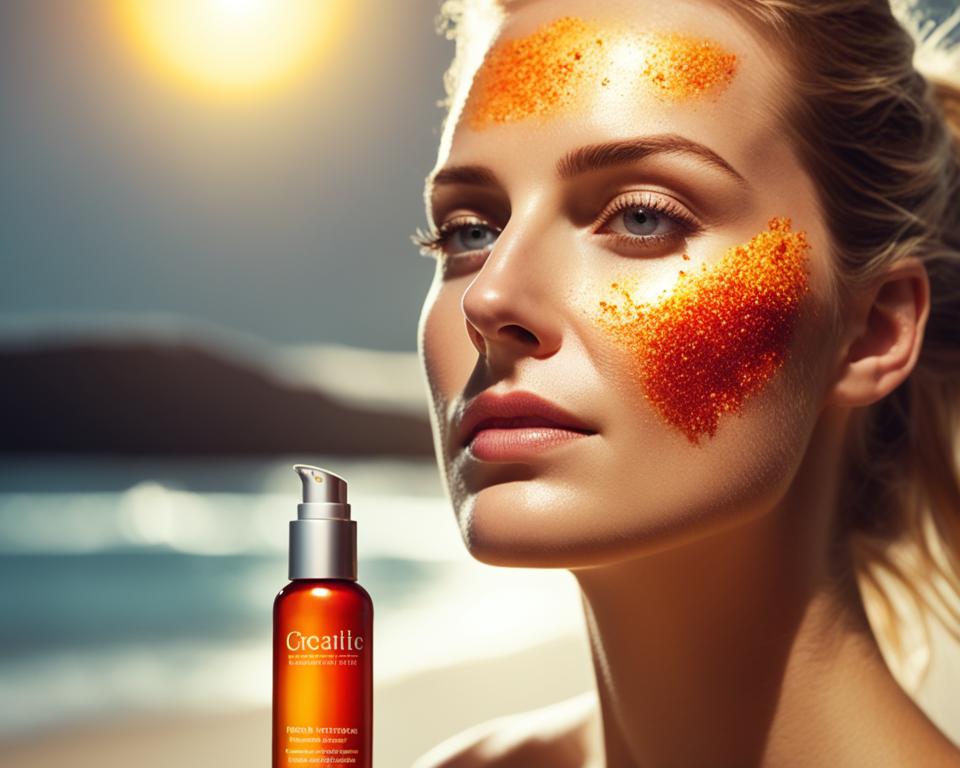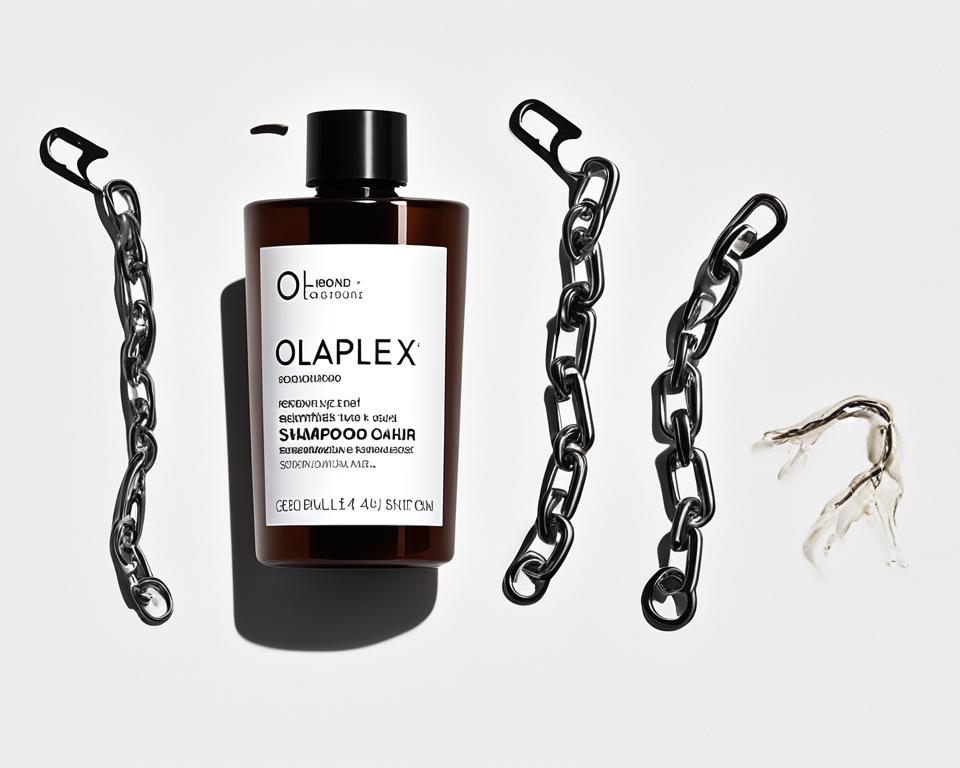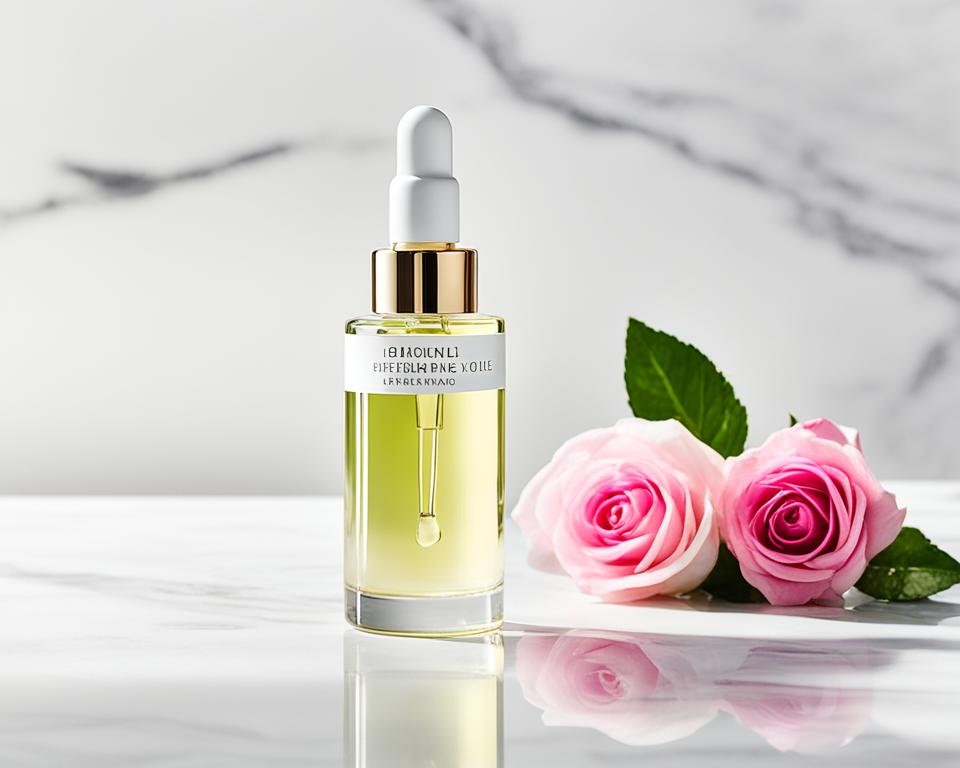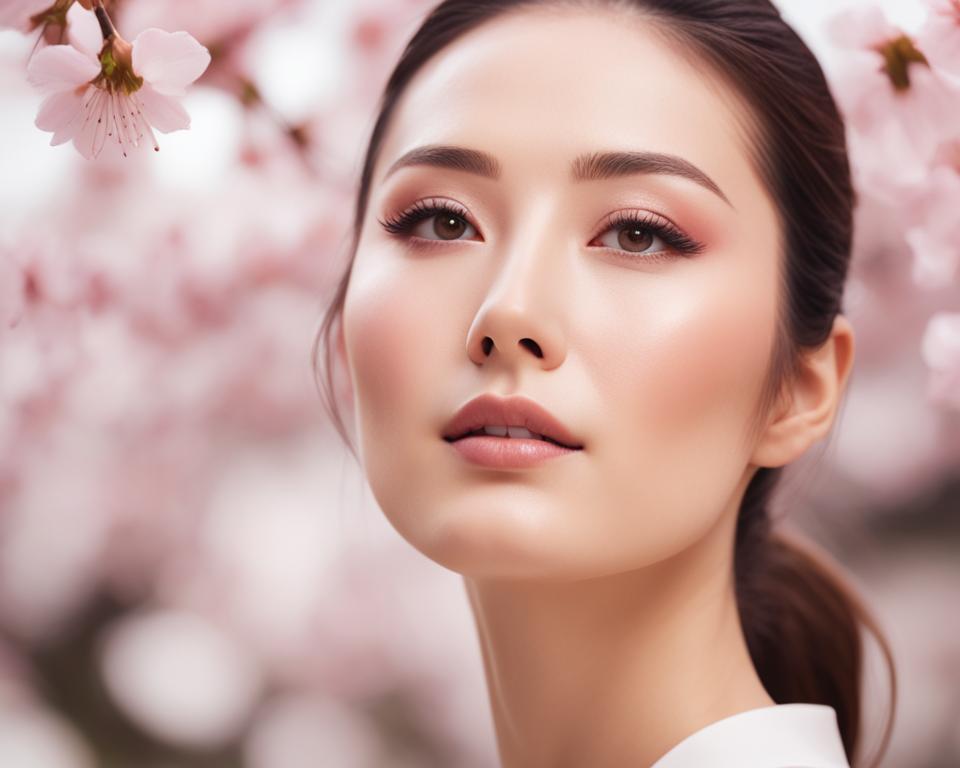Unprotected sun exposure can have detrimental effects on our skin, particularly on the facial area. Sun damage to the facial skin is not only uncomfortable, but it can also lead to long-term consequences. Whether you’ve noticed it or not, uneven sun exposure on one side of the face is a common occurrence that can result from various factors such as driving or spending more time outside.
Understanding the risks associated with sun damage to the facial skin and adopting effective sun protection strategies are vital for maintaining a healthy complexion. By taking proactive measures and incorporating sun protection skincare into our daily routine, we can minimize the harmful effects of sun exposure and safeguard our skin’s health.
In the following sections, we will discuss the causes and effects of sunburn and UV rays, the potential impact of facial asymmetry on sun damage, the importance of daily sun protection, tips for choosing the right sunscreen, other sun protection measures to consider, the significance of eye and lip protection, the role of antioxidants in sun protection, methods to treat sunburn on one side of the face, and the long-term effects of sun exposure.
By the end of this article, you will gain valuable insights into the importance of protecting both sides of your face from sun exposure and learn how to incorporate effective sun protection techniques into your daily skincare routine.
Read more interesting information at ::lansdowne-moody
Understanding Sunburn and UV Rays
When it comes to sun exposure, understanding the harmful effects of UV rays and the risk of sunburn is crucial. UV radiation, a component of sunlight, can cause significant damage to the skin, leading to sunburn and long-term consequences.
UV rays come in two primary forms: UVA and UVB. UVA rays penetrate the deeper layers of the skin and contribute to premature aging and wrinkling. UVB rays, on the other hand, are responsible for sunburn and play a role in the development of skin cancer.
Sunburn occurs when the skin is exposed to excessive UV radiation, resulting in red, painful, and inflamed skin. While sunburn can affect any part of the body, individuals often experience sunburn on one side of the face due to asymmetrical sun exposure. This can be a result of spending extended periods outdoors or one-sided positioning during outdoor activities.
Protecting Against Sunburn and UV Rays
To prevent sunburn and the harmful effects of UV rays, it’s essential to take effective sun protection measures. Here are some key steps to incorporate into your daily routine:
- Apply broad-spectrum sunscreen: Choose a sunscreen that offers protection against both UVA and UVB rays. Apply it generously to all exposed areas of the skin, including the face, ears, and neck.
- Seek shade: Take breaks from direct sun exposure by seeking shade under trees, umbrellas, or using protective clothing like wide-brimmed hats.
- Wear protective clothing: Covering up with long-sleeved shirts, pants, and sunglasses can provide an additional layer of protection against UV rays.
- Avoid peak sun hours: Limit sun exposure during the peak hours of 10 a.m. to 4 p.m., when the sun’s rays are strongest.
- Reapply sunscreen frequently: Sunscreen should be reapplied every two hours or more frequently if swimming or sweating excessively.
Remember, protecting your skin from sunburn and UV rays is not only important for preventing short-term discomfort but also for maintaining long-term skin health.
By understanding the effects of sun exposure and taking appropriate measures to prevent sunburn, you can safeguard your skin and minimize the risk of uneven sun damage on one side of your face.
Facial Asymmetry and Sun Damage
Uneven sun exposure on the face can have a significant impact on facial asymmetry and increase the risk of sun damage on one side. When one side of the face is exposed to more sun than the other, it can lead to differences in pigmentation, texture, and overall appearance. The effects may become more pronounced over time, causing the face to appear imbalanced.
To prevent facial asymmetry and protect against sun damage, it is crucial to prioritize equal sun protection for both sides of the face. Applying sunscreen with a high SPF regularly and evenly on all areas of the face can help minimize the risk of uneven sun damage.
In addition to sunscreen, wearing hats, using umbrellas, and seeking shade when outdoors can provide extra protection against harmful UV rays. These preventive measures help safeguard the skin and maintain its natural symmetry and tone.
However, it’s important to note that existing facial asymmetry cannot be reversed or corrected solely through sun protection. Consulting with a dermatologist or cosmetic professional may be necessary to address any persistent imbalances in facial symmetry.
Understanding Facial Asymmetry:
Facial asymmetry refers to differences in the size, shape, and positioning of facial features between the left and right sides of the face. It is a common characteristic that affects most individuals to some degree. However, excessive sun damage can exaggerate these natural differences, leading to noticeable asymmetry.
“Facial symmetry is a key factor in determining attractiveness, as it is associated with youthfulness and beauty. Uneven sun damage can disrupt this symmetry, affecting the overall harmony and balance of facial features.”
By protecting both sides of the face from sun damage, individuals can help maintain and preserve facial symmetry over time. Ensuring consistent sun protection is essential for a balanced and harmonious appearance.
Importance of Equal Sun Protection:
To effectively prevent sun damage-induced facial asymmetry, it is crucial to provide equal sun protection to both sides of the face. Neglecting one side can result in noticeable differences in pigmentation, texture, and overall skin condition.
Avoiding these imbalances requires a comprehensive sun protection routine that includes applying sunscreen evenly, wearing protective clothing, and seeking shade when necessary. By adopting these practices, individuals can promote facial symmetry and minimize the risk of sun damage.
| Facial Asymmetry and Sun Damage: Prevention Tips | Common Causes of Facial Asymmetry | Recommended Sun Protection Practices |
|---|---|---|
| Apply sunscreen with a high SPF on both sides of the face | Genetic factors | Wear protective clothing, such as wide-brimmed hats |
| Seek shade when the sun is at its peak | Environmental factors | Use an umbrella when outdoors |
| Wear sunglasses with UV protection to shield the eyes | Age-related changes | Reapply sunscreen every two hours or after swimming or sweating |
| Avoid excessive sun exposure | Facial trauma or injuries | Consult a dermatologist for personalized sun protection recommendations |
The Importance of Daily Sun Protection
Protecting your skin from the sun’s harmful rays is essential for maintaining the health and appearance of your skin. Daily sun protection is not only crucial for preventing sunburn but also for reducing the risk of long-term sun damage, such as wrinkles, dark spots, and premature aging.
When it comes to sun protection, a comprehensive skincare routine is key. Incorporating sun protection products into your daily regimen can help shield your skin from the damaging effects of UV radiation. There are several methods and products available to ensure effective sun protection:
- Sunscreen: Applying sunscreen with a high SPF (Sun Protection Factor) is vital for safeguarding your skin against both UVA and UVB rays. Choose a broad-spectrum sunscreen that offers protection from a wide range of wavelengths to shield your skin from the harmful effects of the sun.
- Moisturizers with SPF: If you prefer a multi-purpose product, opt for moisturizers or foundations that have built-in SPF. These products provide hydration and sun protection in one, making them convenient for daily use.
- Lip Balm: Don’t forget to protect your lips from sun damage. Look for lip balms that contain SPF to keep your lips moisturized while shielding them from harmful UV rays.
- Hats and Clothing: Wearing wide-brimmed hats and clothing that covers your skin can provide an additional layer of protection against the sun. Opt for lightweight, breathable fabrics with a tight weave for optimal sun protection.
- Sunglasses: Protecting your eyes from the sun is just as important as protecting your skin. Choose sunglasses with UV protection to shield your eyes from harmful UV rays and reduce the risk of eye conditions caused by long-term sun exposure.
Remember, sun protection is not only necessary during the summer months but all year round. Even on cloudy days, UV rays can still penetrate through the clouds and cause damage to your skin. By prioritizing daily sun protection, you can help minimize the risk of sunburn, skin damage, and other sun-related issues, ensuring a healthier complexion for years to come.
Choosing the Right Sunscreen
When it comes to protecting your skin from harmful sun exposure, choosing the right sunscreen is crucial. Not all sunscreens are created equal, and understanding how to select the best one for your needs is key to effective sun protection.
One of the primary factors to consider when choosing a sunscreen is the Sun Protection Factor (SPF). SPF indicates the level of protection the sunscreen offers against UVB rays, which are responsible for sunburn and can contribute to skin cancer. The higher the SPF number, the greater the level of protection. It is generally recommended to choose a sunscreen with an SPF of 30 or higher.
Additionally, look for sunscreens that provide broad-spectrum coverage. This means they protect against both UVA and UVB rays. UVA rays can penetrate deeper into the skin and contribute to premature aging and skin damage.
The selection of a sunscreen should also take into account your personal skin type. If you have dry skin, opt for a sunscreen with moisturizing properties to prevent dryness and maintain hydration. For oily or acne-prone skin, look for oil-free or non-comedogenic sunscreens that won’t clog pores or contribute to breakouts.
Knowing how to apply sunscreen effectively is just as important as choosing the right one. Remember to generously apply sunscreen to all exposed areas of your skin at least 15 minutes before sun exposure. Reapply every two hours or more frequently if you are swimming or sweating.
By carefully considering the SPF, broad-spectrum coverage, and your skin’s specific needs, you can confidently select a sunscreen that will provide the necessary protection against harmful UV rays.
Sunscreen Selection Tips:
- Choose a sunscreen with an SPF of 30 or higher.
- Look for broad-spectrum coverage to protect against UVA and UVB rays.
- Select a sunscreen suitable for your skin type (e.g., moisturizing for dry skin, oil-free for oily or acne-prone skin).
- Apply sunscreen generously to all exposed areas of skin at least 15 minutes before sun exposure.
- Reapply sunscreen every two hours or more frequently if swimming or sweating.
| Sunscreen Brand | SPF | Broad-Spectrum | Suitable for Skin Type | Price Range |
|---|---|---|---|---|
| CeraVe Facial Moisturizing Lotion SPF 30 | 30 | Yes | Dry and Normal Skin | $15 – $20 |
| Neutrogena Ultra Sheer Dry-Touch Sunscreen SPF 55 | 55 | Yes | Normal to Oily Skin | $10 – $15 |
| La Roche-Posay Anthelios Melt-In Sunscreen Milk SPF 60 | 60 | Yes | Sensitive Skin | $25 – $30 |
| EltaMD UV Clear Facial Sunscreen SPF 46 | 46 | Yes | Acne-Prone Skin | $30 – $35 |
“Protecting your skin from the harmful effects of the sun starts with selecting the right sunscreen. By considering factors such as SPF, broad-spectrum coverage, and your skin type, you can ensure that your skin receives the necessary sun protection it needs.”
– Dr. Emily Johnson, Dermatologist
Other Sun Protection Measures
While sunscreen is an essential component of sun protection skincare, there are other measures you can take to prevent sun damage and keep your skin healthy. Incorporating these practices into your daily routine can help ensure comprehensive sun exposure prevention.
1. Wear Protective Clothing
One effective way to shield your skin from the harmful effects of the sun is to wear protective clothing. Opt for long-sleeved shirts, wide-brimmed hats, and sunglasses with UV protection. Clothing made from UPF (Ultraviolet Protection Factor) fabric can provide an additional layer of defense against the sun’s rays.
2. Seek Shade
When spending time outdoors, seek shade whenever possible. Trees, umbrellas, and canopies offer natural protection from the sun’s direct rays. By staying in shaded areas, you can reduce your sun exposure and lower the risk of sun damage.
3. Avoid Peak Sun Hours
To minimize sun exposure, it’s advisable to avoid being outdoors during peak sun hours, typically between 10 a.m. and 4 p.m. During these times, the sun’s rays are the strongest and can cause the most damage to your skin. If you must be outside, make sure to take extra precautions by using sunscreen and wearing protective clothing.
Remember, even on cloudy days, UV rays can penetrate through the clouds and reach your skin. So, it’s important to practice sun protection regardless of the weather.
4. Stay Hydrated
Drinking an adequate amount of water throughout the day is crucial for maintaining healthy skin. Proper hydration helps to keep your skin moisturized and supple, protecting it from dryness and potential sun damage.
5. Protect Your Lips
Don’t forget to protect your lips from the sun’s rays. Use a lip balm with SPF to provide sun protection for this sensitive area. Regular application of lip balm will help prevent sunburn and keep your lips well moisturized.
6. Consider Additional Sun Protection Products
In addition to sunscreen, there are other sun protection skincare products available that can further enhance your defense against sun damage. Look for moisturizers, serums, and foundations that contain SPF to provide continuous protection throughout the day.
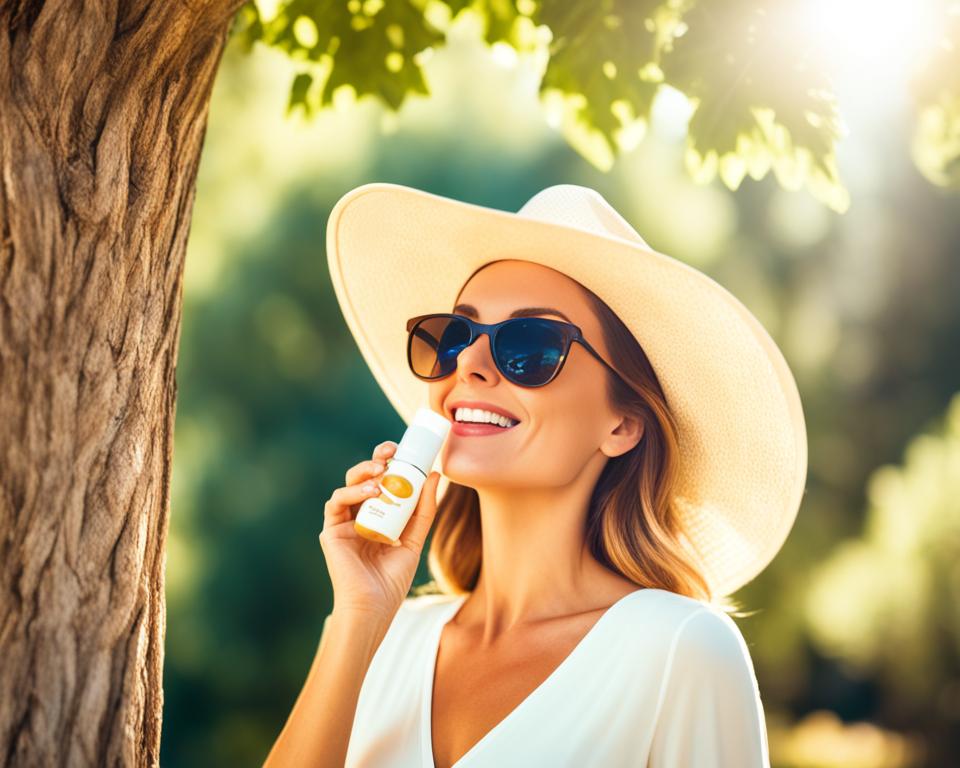
7. Summary Table: Sun Protection Measures
Here’s a comprehensive summary table outlining the various sun protection measures discussed in this section:
| Sun Protection Measure | Description |
|---|---|
| Wear Protective Clothing | Long-sleeved shirts, wide-brimmed hats, and sunglasses with UV protection |
| Seek Shade | Stay in shaded areas such as trees, umbrellas, and canopies |
| Avoid Peak Sun Hours | Minimize outdoor activities between 10 a.m. and 4 p.m. |
| Stay Hydrated | Drink plenty of water to keep your skin moisturized |
| Protect Your Lips | Use lip balm with SPF to shield your lips from sun damage |
| Consider Additional Sun Protection Products | Look for skincare products with built-in SPF for extra defense against sun damage |
By incorporating these sun protection measures into your daily routine, you can effectively prevent sun damage and maintain the health and vitality of your skin.
Importance of Eye Protection
The skin around our eyes is delicate and highly vulnerable to sun damage. That’s why it’s crucial to prioritize eye protection when it comes to sun exposure prevention. Wearing sunglasses with UV protection is essential for preventing sun damage to the eyes and reducing the risk of eye conditions such as cataracts and macular degeneration.
UV rays have the potential to harm the eyes by damaging the sensitive tissues and increasing the likelihood of vision problems. By shielding our eyes with sunglasses that provide UV protection, we can prevent sun damage and maintain good eye health.
When selecting sunglasses, look for ones that offer 100% UV protection to ensure maximum eye safety. This will block both UVA and UVB rays, effectively preventing sun damage. Additionally, choose sunglasses that provide proper coverage, fitting comfortably and securely on your face.
Remember that UV rays can still reach your eyes even on cloudy days, so wearing sunglasses should be part of your daily routine, regardless of the weather. By making eye protection a priority, you can reduce the risk of sun damage and maintain the health of your precious eyes.
Tips for choosing sunglasses:
- Opt for sunglasses that offer 100% UV protection.
- Ensure proper coverage by selecting sunglasses that fit securely on your face.
- Select sunglasses with lenses that reduce glare and provide clear vision.
- Consider polarized sunglasses for enhanced eye protection.
Sun Protection for Lips
While it’s easy to remember to protect our skin from the sun, one area often overlooked is the lips. The delicate skin on our lips is susceptible to sun damage, dryness, and even sunburn. That’s why incorporating sun protection for our lips is essential in maintaining overall skin health.
To prevent sun damage and keep your lips moisturized, it’s crucial to use lip balms with SPF. Look for lip balms that offer broad-spectrum protection, shielding against both UVA and UVB rays. A minimum SPF of 30 is recommended for adequate sun protection.
When choosing a lip balm, opt for one that is labeled as water-resistant. This ensures that the protection remains intact even during activities that may cause sweating or water exposure. Reapply the lip balm every two hours or more frequently if you eat, drink, or wipe your lips.
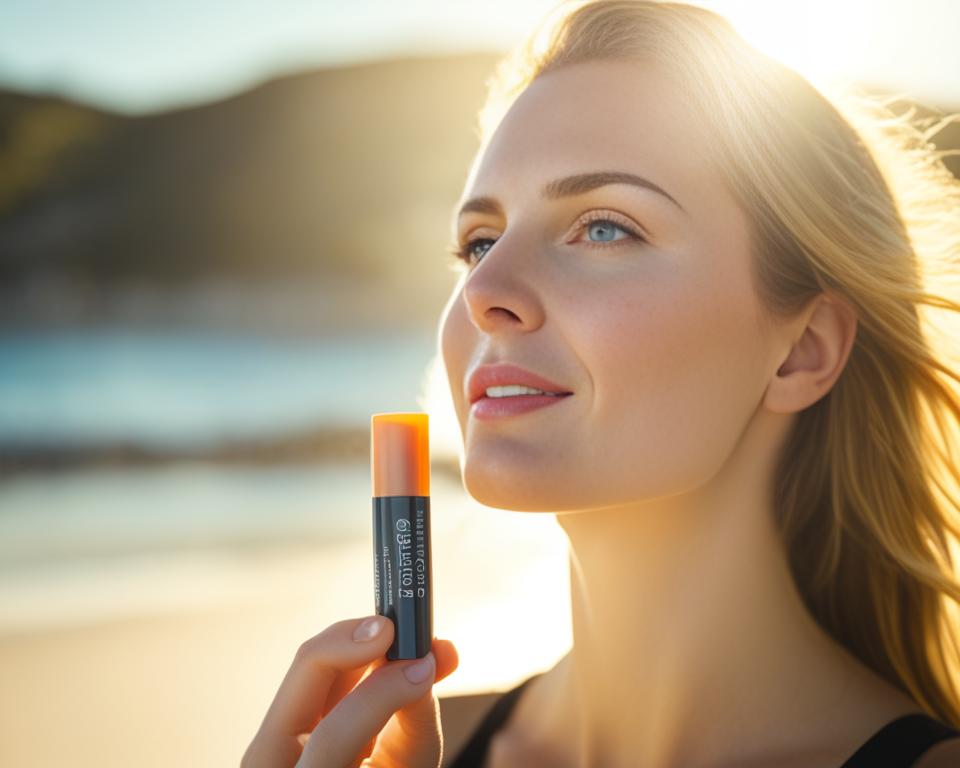
Wearing lip balm with SPF not only shields your lips from sunburn but also prevents dryness and chapping. Exposure to the sun’s rays can lead to dehydrated lips, causing discomfort and flakiness. By using SPF lip balms, you can keep your lips nourished, soft, and protected.
Tips for Sun Protection on Lips:
- Apply lip balm with SPF 30 or higher.
- Choose lip balms that offer broad-spectrum protection.
- Opt for water-resistant lip balms.
- Reapply every two hours or more frequently as needed.
- Use lip balm even on cloudy days, as UV rays can still penetrate through the clouds.
- Consider using lipsticks or lip glosses with built-in SPF for added protection and color.
By incorporating specific sun protection measures for your lips, you can ensure that this often neglected area remains healthy and shielded from the harmful effects of UV rays. Don’t forget to include lip balm with SPF as part of your daily skincare routine to keep your lips looking and feeling their best.
The Role of Antioxidants in Sun Protection
When it comes to sun protection skincare, incorporating antioxidants into your routine can significantly help prevent sun damage. Antioxidants are powerful substances that can neutralize harmful free radicals caused by sun exposure, minimizing their negative effects on the skin.
Antioxidants are known for their ability to support the skin’s natural defense mechanisms, enhancing its ability to withstand the damaging effects of UV rays. By neutralizing free radicals, antioxidants help reduce inflammation and oxidative stress, which can contribute to premature aging and other sun-related skin issues.
One of the key benefits of using antioxidant-rich products is their ability to boost the effectiveness of sunscreen. When applied topically, antioxidants can work synergistically with sunscreens to provide enhanced protection against UV damage. They can also help repair damaged skin cells and promote the skin’s natural healing process.
There are various antioxidants commonly used in sun protection skincare. Some popular examples include:
- Vitamin C: Known for its brightening and protective properties, vitamin C is a potent antioxidant that helps shield the skin from UV-induced damage.
- Vitamin E: This antioxidant provides nourishment and hydration to the skin while protecting it from harmful environmental factors, including sun exposure.
- Green tea extract: Rich in antioxidants such as polyphenols, green tea extract helps reduce inflammation and protects the skin from UV damage.
By incorporating products containing these antioxidants into your daily skincare routine, you can fortify your skin’s defenses against sun damage. However, it’s important to note that antioxidants alone cannot replace the need for sun protection measures like sunscreen and seeking shade. They should be used in conjunction with a comprehensive sun protection strategy for optimal results.
With the growing awareness of the role antioxidants play in sun protection, numerous skincare brands are formulating products that harness the power of these beneficial compounds. When selecting sun protection skincare products, look for those that contain antioxidants and offer broad-spectrum protection against both UVA and UVB rays.
“Incorporating antioxidants into your sun protection routine can help prevent sun damage and support healthy, youthful-looking skin.”
Treating Sunburn on One Side of the Face
Sunburn on one side of the face can be uncomfortable and unsightly. It is important to take immediate steps to treat the sunburned skin to relieve discomfort and promote healing. Here are some effective remedies and soothing techniques:
- Cool Compresses: Apply a cool compress or damp cloth to the sunburned area to reduce inflammation and soothe the skin.
- Aloe Vera Gel: Apply a generous amount of pure aloe vera gel to the sunburned skin. Aloe vera has natural cooling properties that can provide relief and help the skin heal.
- Hydration: Drink plenty of water to stay hydrated and moisturize the skin from within.
- Moisturizers: Apply a gentle, fragrance-free moisturizer to the sunburned skin to prevent dryness and promote healing.
- Pain Relief: Over-the-counter pain relievers such as ibuprofen can help alleviate pain and reduce inflammation.
If the sunburn is severe or accompanied by blisters, it is recommended to seek medical attention. Remember, prevention is always better than cure. Protect your skin from the harmful effects of sun exposure by wearing sunscreen, seeking shade, and wearing protective clothing.
| Treating Sunburn on One Side of the Face | Benefits |
|---|---|
| Cool Compresses | Reduces inflammation Soothes the skin |
| Aloe Vera Gel | Cools and moisturizes Promotes healing |
| Hydration | Prevents dehydration Moisturizes the skin |
| Moisturizers | Prevents dryness Aids in healing |
| Pain Relief | Alleviates pain and inflammation |
Long-Term Effects of Sun Exposure
Sun exposure can have significant long-term effects on the skin, causing various issues such as aging, wrinkles, and hyperpigmentation. It is crucial to prioritize sun protection in order to prevent these detrimental effects and maintain a healthy complexion.
One of the primary long-term effects of sun exposure is premature aging. Excessive sun exposure can accelerate the aging process, leading to the formation of fine lines, wrinkles, and a loss of skin elasticity. The harmful UV rays from the sun can break down collagen and elastin, essential proteins that keep the skin firm and supple.
Furthermore, sun damage can contribute to the development of hyperpigmentation, or dark spots, on the skin. Prolonged exposure to the sun can stimulate the production of melanin, the pigment responsible for skin color. Uneven distribution of melanin due to sun exposure can result in the formation of dark patches, freckles, and sunspots.
To prevent these long-term effects of sun exposure, it is crucial to establish a comprehensive sun protection routine. Here are some key strategies to incorporate:
- Use a broad-spectrum sunscreen with a high SPF (Sun Protection Factor) to shield your skin from both UVA and UVB rays. Reapply every two hours, especially when exposed to direct sunlight.
- Seek shade and limit your time in the sun, especially during peak hours when the sun’s rays are the strongest (typically between 10 am and 4 pm).
- Wear protective clothing, such as long-sleeved shirts, pants, and broad-brimmed hats, to reduce direct sun exposure to your skin.
- Wear sunglasses with UV protection to shield your eyes from harmful rays and reduce the risk of eye damage.
Incorporating these sun protection measures into your daily routine can help prevent the long-term effects of sun exposure and promote healthier, more youthful-looking skin. Remember, prevention is key when it comes to sun damage!
Sun Damage Prevention Tips
Here are some additional sun damage prevention tips to keep in mind:
- Avoid tanning beds and sunlamps, as they emit harmful UV radiation that can accelerate skin damage.
- Protect your lips by using a lip balm with SPF. Lips are often overlooked but can be susceptible to sunburn and dryness.
- Consider incorporating antioxidant-rich skincare products into your routine. Antioxidants can help neutralize free radicals caused by sun exposure and minimize the resulting damage.
Remember, the sun’s harmful rays can penetrate clouds and windows, so it’s essential to practice sun protection even on cloudy or indoor days.
By adopting these sun protection habits and prioritizing the health of your skin, you can minimize the long-term effects of sun exposure and enjoy a more radiant and youthful complexion.
| Long-Term Effects of Sun Exposure | Prevention Strategies |
|---|---|
| Premature aging | Use a broad-spectrum sunscreen, seek shade, wear protective clothing and sunglasses |
| Wrinkles and loss of skin elasticity | Reapply sunscreen, limit sun exposure during peak hours |
| Hyperpigmentation (dark spots) | Wear protective clothing, use lip balm with SPF, incorporate antioxidants in skincare routine |
Incorporating Sun Protection into Daily Routine
Protecting your skin from the damaging effects of the sun is crucial for maintaining a healthy complexion and preventing long-term sun damage. By incorporating sun protection into your daily skincare routine, you can ensure that your skin is shielded from harmful UV rays, both indoors and outdoors.
1. Wear Sunscreen Every Day
The most essential step in sun protection skincare is to apply sunscreen daily. Choose a broad-spectrum sunscreen with an SPF of 30 or higher to protect your skin from both UVA and UVB rays. Apply it generously to all exposed areas of your face and body, including your neck and ears. Reapply every two hours, or more frequently if you are sweating or swimming.
2. Seek Shade During Peak Sun Hours
Limit your sun exposure by seeking shade, especially during the peak sun hours between 10 a.m. and 4 p.m. If you need to be outdoors during these hours, try to stay in shaded areas or use umbrellas and wide-brimmed hats to provide additional protection.
3. Wear Protective Clothing
Covering up with protective clothing can significantly reduce your sun exposure. Opt for long-sleeved shirts, pants, and skirts made of tightly woven fabrics. Don’t forget to wear a wide-brimmed hat and UV-protective sunglasses to shield your face and eyes.
4. Apply Lip Balm with SPF
Your lips are often overlooked when it comes to sun protection. Protect them by using a lip balm with SPF. Apply it generously throughout the day to prevent both sunburn and dryness.
5. Use Antioxidant-Rich Skincare Products
Incorporate antioxidant-rich skincare products into your routine to further enhance your skin’s defense against sun damage. Look for ingredients like vitamin C, vitamin E, and green tea extract, which have been shown to neutralize free radicals caused by UV radiation.
“Sun protection should be a non-negotiable part of everyone’s daily skincare routine. By incorporating these simple tips into your daily life, you can minimize the risk of sun damage and keep your skin healthy and radiant.”
| Sun Protection Tips | Sun Exposure Prevention |
|---|---|
| Wear sunscreen with SPF 30 or higher | Seek shade during peak sun hours |
| Cover up with protective clothing | Apply lip balm with SPF |
| Use antioxidant-rich skincare products | – |
Conclusion
In conclusion, protecting both sides of the face from sun exposure is essential for maintaining healthy and evenly toned facial skin. Uneven sun exposure can lead to facial asymmetry, sunburn, and long-term effects such as wrinkles and hyperpigmentation. To prevent these issues, it is crucial to prioritize sun protection strategies.
By understanding the harmful effects of UV rays and incorporating daily sun protection measures, such as applying sunscreen with a high SPF, seeking shade, and wearing protective clothing, individuals can effectively safeguard their skin from sun damage. Additionally, protecting the eyes with UV-protective sunglasses and the lips with SPF lip balms is equally important.
Furthermore, incorporating antioxidants into skincare routines can provide an additional layer of defense against sun damage. Antioxidant-rich ingredients help neutralize free radicals caused by sun exposure, minimizing the risk of skin damage. By adopting these sun protection practices into daily routines, individuals can enjoy healthy, youthful-looking skin for years to come.
